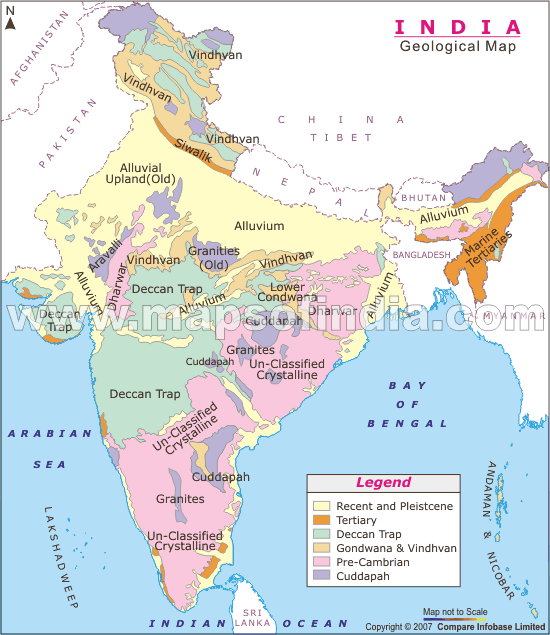Indian Geography (part-5)
Rock System Of India
Geological rocks: - The term refers to rocks found under the ground. The earth was initially like a ball of fire. Over time, the rocks began to be formed for the hot earth to cool. Different types of rocks were formed in India at different times. A total of 6 types of rocks are found in India. Based on the construction period of the rocks, their order is as follows -
- The Archaean Rock System.
- The DharwadRock System.
- The Cuddapah Rock System.
- The Vindhyan Rock System.
- The Gondwana Rock System.
- The Deccan Trap.

- The Archaean Rock System:-
- The Archaean rocks were first to be formed on Earth. In other words, it can be said that the oldest rocks on Earth are rocks of Archean system.
- There are no fossils found in them.
- The rocks of the Archaean system are found mainly in Karnataka, Tamil Nadu, Andhra Pradesh, Madhya Pradesh, Orissa, Chota Nagpur plateau in Jharkhand and the southern-eastern part of Rajasthan.
- The Dharwad Rock System:-
- The rocks of the Dharwad system have been named after the Dharwad district of Karnataka, as these rocks were first discovered in Dharwad district.
- The rocks of the Dharwad system are found mainly in two regions in India -
- In Karnataka region
- In Aravalli region
- Dharwad rocks are found in three districts of Karnataka –
- Dharwad District
- Bellary District
- Shimoga District
- Economically, the rocks of the Dharwad system are quite rich. Major metals of India, which include metals like gold, manganese, copper, zinc, chromium, tungsten and iron, are found in Dharwad rocks.
- In India, gold is found in Kolar and Hatti mines under rocks of Dharwad system.
- The Kuddapah Rock System:-
- After the rocks of the Dharwad system, the rocks of the Kudappa system were formed.
- The rocks of the Kudappa system are named after the Kudappa district of Andhra Pradesh, as these rocks were first found in the Kudappa district of Andhra Pradesh.
- The Vindhyan Rock System:-
- Vindhyan rocks are found in the area under and around the Vindhya Mountains. Vindhyan system rocks are also found in some quantity in Andhra Pradesh.
- The main feature of Vindhyan rocks is that these rocks are famous for building materials. For example -limestone, sandstone, marble etc.
- Diamond is produced from the Panna mines in Madhya Pradesh and Golconda mines in Andhra Pradesh, these mines are located in the rocks of the Vindhyan rock system.
- The Gondwana Rock System:-
- These rocks are found mainly in river valleys in India.
- The extension of rocks of Gondwana system is found mainly in three river valleys in India.
- Damodar river valley.
- Mahanadi valley.
- Godavari river valley.
- About 98% of India's coal is found in these rocks, which is the bituminous type of coal and considered as second class coal. This means that coal is mainly found in the Damodar river valley, Mahanadi valley and Godavari river valleys in India.
- Singaraini coalfield in Andhra Pradesh is located in the Godavari river valley.
- Talcher Coalfield is located in the Mahanadi Valley in Orissa.
- Jharia coalfield in Orissa is in Damodar river valley.
- The Deccan Trap:-
- The Deccan Plateau, located in Maharashtra and its surrounding areas, is called the Deccan Trap.
- Peninsular India and the continent of Africa are part of Gondwanaland, India was separated from Africa and is flowing in the north and east direction.
- To break away from the African continent of peninsular India, a cracking flow of lava was produced on the west coast of India and the hot lava coming out of the cracks spread all over the surface. After this lava froze and a plateau was formed, it is called the Deccan Plateau. The rocks formed by the deposition of lava are called basalt rocks. Therefore, when weathering of these basalt rocks occurs, the soil formed from it is called black soil.
- The main part of Deccan Trap is located in the state of Maharashtra, about 75-80% of it is spread in Maharashtra and some part in the states of Madhya Pradesh and Gujarat.
- Black soil is formed from lava rocks, hence it is also called lava soil. Black soil is also called Rengur soil. Black soil is considered suitable for cotton cultivation, hence it is also called Kapasi soil.

Very interesting and simple
ReplyDelete👌 appreciable
ReplyDelete